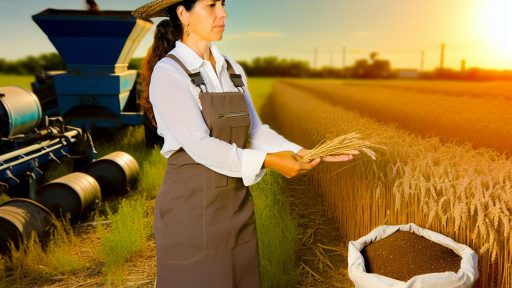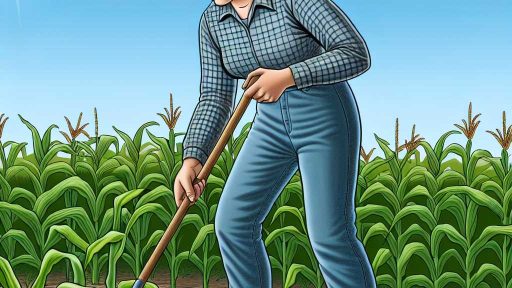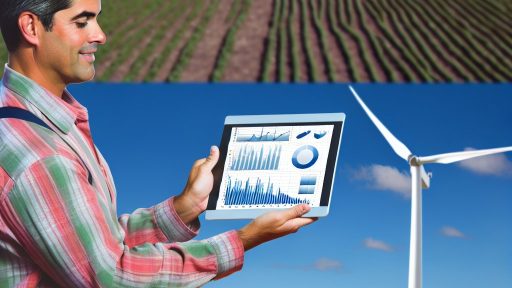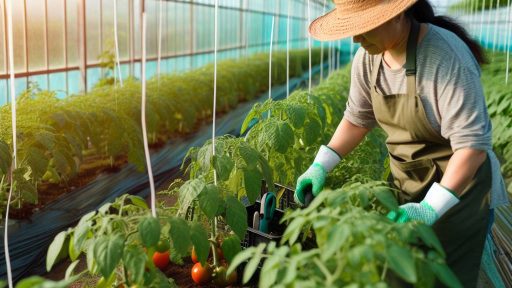Introduction to Greenhouse Cultivation and Its Importance
Greenhouse cultivation allows farmers to grow crops in a controlled environment.
This method effectively addresses water usage in agriculture.
Water scarcity poses a significant challenge to global food production.
As a result, innovative farming practices are crucial for sustainability.
Optimizing Water Usage
Greenhouses create an ideal microclimate for plants.
This setup reduces water evaporation significantly.
Additionally, water resources are recycled through various systems.
Droplet irrigation is one effective method employed in greenhouses.
Such techniques ensure plants receive adequate water without waste.
Enhancing Crop Yields
Greenhouse cultivation often leads to higher crop yields.
This is particularly important in regions facing water shortages.
Farmers can harvest more produce with less water input.
Furthermore, controlled conditions protect crops from pests and diseases.
This contributes to overall agricultural efficiency and sustainability.
Environmental Benefits
Greenhouses contribute to reduced chemical usage in farming.
Transform Your Agribusiness
Unlock your farm's potential with expert advice tailored to your needs. Get actionable steps that drive real results.
Get StartedThe controlled environment limits the need for fertilizers and pesticides.
This practice leads to less runoff into nearby water sources.
Consequently, greenhouse farming promotes better water quality.
Moreover, it reduces the ecological footprint of agriculture.
Overview of Water Scarcity Issues in Agriculture
Water scarcity remains a pressing issue in global agriculture.
It impacts food production and contributes to rising prices.
As populations grow, the demand for water intensifies.
Conventional farming methods often waste significant water resources.
This inefficiency leads to unsustainable practices in many regions.
Statistics on Water Use in Agriculture
Agriculture accounts for about 70% of global freshwater use.
This sector faces tremendous pressure to use water wisely.
In many countries, irrigation systems are outdated and inefficient.
Moreover, crop selection does not always consider water availability.
Consequently, water shortages can lead to crop failures.
Regions Most Affected by Water Scarcity
Several areas face severe water scarcity challenges.
Regions like Sub-Saharan Africa experience extreme limitations.
Similarly, parts of South Asia deal with groundwater depletion.
These regions struggle to sustain food production.
Vulnerable communities often bear the brunt of these challenges.
The Impact on Food Security
Water scarcity directly threatens food security worldwide.
It leads to reduced agricultural output, causing shortages.
Families may face increased hunger in marginalized communities.
As food prices rise, access becomes limited for many people.
Addressing water use in agriculture is essential for sustainability.
Showcase Your Farming Business
Publish your professional farming services profile on our blog for a one-time fee of $200 and reach a dedicated audience of farmers and agribusiness owners.
Publish Your ProfileInnovative Solutions to Water Scarcity
Farmers must adopt innovative practices to conserve water.
Technologies like drip irrigation improve efficiency significantly.
Using drought-resistant crop varieties can also help.
Furthermore, rainwater harvesting presents a viable option.
These strategies can mitigate the effects of water scarcity effectively.
Benefits of Greenhouse Cultivation for Water Management
Efficient Water Usage
Greenhouses optimize water consumption compared to traditional farming.
They provide a controlled environment for plants.
This controlled setting reduces evaporation rates significantly.
Additionally, greenhouse systems enable precise irrigation methods.
Techniques such as drip irrigation ensure water reaches the roots directly.
Minimized Water Waste
In greenhouses, water loss is considerably minimized.
Closed systems capture and reuse excess water effectively.
This approach significantly reduces overall water usage.
Consequently, farmers can cultivate more crops with less water.
Improved Crop Quality and Yield
Greenhouses promote healthy plant growth through optimal conditions.
This leads to higher-quality produce and increased yields.
With less water required, farmers can achieve greater efficiency.
Furthermore, healthier plants are typically more resilient to pests.
Adaptability to Climate Variations
Greenhouses provide a stable environment for crops regardless of external conditions.
This adaptability becomes crucial during droughts or extreme weather events.
Farmers can maintain production levels with consistent water resources.
Ultimately, this resilience helps secure food supplies in changing climates.
Support for Sustainable Practices
Employing greenhouse cultivation aligns with sustainable agricultural practices.
It reduces pressure on local water resources.
This method promotes eco-friendly farming approaches.
Moreover, sustainable practices ensure the longevity of agriculture.
Thus, greenhouse cultivation emerges as a vital water management strategy.
You Might Also Like: Pest And Disease Forecasting For Effective Crop Management
Techniques for Efficient Water Use in Greenhouses
Implementing Drip Irrigation
Drip irrigation delivers water directly to plant roots.
This method minimizes evaporation and runoff.
Farmers can adjust water flow based on plant needs.
As a result, they achieve significant water savings.
Utilizing Rainwater Harvesting
Rainwater harvesting captures runoff from greenhouse roofs.
Storage systems collect and store this rainwater for use.
This sustainable practice reduces reliance on external water sources.
Additionally, it helps in managing stormwater runoff efficiently.
Optimizing Greenhouse Design
Good greenhouse design maximizes natural light and heat.
Orientation and airflow enhance water evaporation rates.
Furthermore, insulated materials retain moisture effectively.
These features contribute to reduced water requirements for crops.
Showcase Your Farming Business
Publish your professional farming services profile on our blog for a one-time fee of $200 and reach a dedicated audience of farmers and agribusiness owners.
Publish Your ProfileImplementing Soil Moisture Sensors
Soil moisture sensors monitor water levels in the soil.
These devices provide real-time data on irrigation needs.
Implementing them prevents overwatering and underwatering.
Efficient use of water promotes healthier plant growth.
Employing Mulching Techniques
Mulching helps retain soil moisture during dry periods.
This technique reduces evaporation and soil temperature fluctuations.
Organic mulches improve soil structure and health over time.
Ultimately, they require less frequent watering.
Utilizing Hydroponics and Aeroponics
Hydroponics and aeroponics use minimal water compared to traditional methods.
These systems allow for nutrient delivery directly to plant roots.
Moreover, they promote faster growth rates in crops.
Reduced water use makes them highly efficient options.
Gain More Insights: Essential Mulching Practices for Successful Farming
Comparative Analysis: Greenhouse vs. Traditional Farming Water Usage
Overview of Water Usage in Agriculture
Water is a critical resource in agriculture.
Traditional farming practices often lead to significant water waste.
In contrast, greenhouse cultivation uses water more efficiently.
Water Efficiency in Greenhouses
Greenhouses utilize controlled environments to retain moisture.
They minimize evaporation and runoff, which saves water.
Moreover, advanced irrigation systems, such as drip irrigation, enhance efficiency further.
This method delivers water directly to the plant roots.
As a result, plants receive the optimal amount of water needed for growth.
Water Usage in Traditional Farming
Traditional farming often involves large-scale water applications.
Inefficient methods, like flood irrigation, exacerbate water loss.
Additionally, factors such as soil evaporation can significantly reduce water efficiency.
Consequently, many traditional farms face challenges related to water scarcity.
Comparative Water Consumption Data
Numerous studies reveal stark differences in water consumption.
For instance, greenhouses may use up to 90% less water than traditional farms.
This discrepancy highlights the potential of greenhouse systems.
Furthermore, greenhouse systems can produce more yield with less water.
Long-Term Benefits of Reduced Water Usage
Reducing water usage is essential for sustainability in agriculture.
Greenhouses contribute to conservation efforts by minimizing resource waste.
Additionally, they help cultivate crops in water-scarce regions.
This adaptability supports food security in changing climates.
Real-world Applications and Case Studies
Many farmers have adopted greenhouse practices successfully.
For example, Sarah from Green Valley Farms saw a 70% reduction in water use.
Her yields increased significantly, showcasing the method’s effectiveness.
Such success stories encourage further adoption of greenhouse technologies.
Explore Further: Innovative Packaging Ideas to Extend Shelf Life

Innovative Technologies in Greenhouse Water Conservation
Smart Irrigation Systems
Smart irrigation systems optimize water usage in greenhouses.
They use sensors to determine soil moisture levels.
Showcase Your Farming Business
Publish your professional farming services profile on our blog for a one-time fee of $200 and reach a dedicated audience of farmers and agribusiness owners.
Publish Your ProfileAdditionally, these systems adapt watering schedules based on weather forecasts.
As a result, they significantly reduce water waste.
Rainwater Harvesting
Rainwater harvesting collects and stores rainwater for irrigation.
Greenhouses can integrate storage tanks to utilize this resource effectively.
This method lowers dependency on traditional water sources.
Moreover, it enhances the sustainability of greenhouse operations.
Hydroponics and Aeroponics
Hydroponics eliminates the need for soil-based growing.
This technique uses nutrient-rich water solutions.
Aeroponics further reduces water usage by misting roots directly.
Both methods ensure faster plant growth with minimal water waste.
Water Recycling Systems
Implementing water recycling systems is crucial for conservation.
These systems treat and reuse water from greenhouse operations.
They capture excess water from irrigation and condensation.
Consequently, this practice reduces the overall water footprint.
Climate Control Technologies
Advanced climate control systems maintain optimal growing conditions.
They regulate temperature and humidity effectively.
Better climate control leads to reduced water evaporation rates.
This ensures that plants receive the necessary moisture without excess loss.
You Might Also Like: Automating Your Hydroponic Farm
Case Studies of Successful Greenhouse Farms Reducing Water Use
Innovative Techniques in Water Management
Greenhouse farms have adopted innovative techniques to manage water efficiently.
For instance, drip irrigation systems deliver water directly to plant roots.
This method minimizes evaporation and runoff, conserving valuable resources.
Additionally, rainwater harvesting systems collect and store rain for irrigation.
This practice significantly reduces dependence on municipal water supply.
Examples from Around the World
Many greenhouse farms globally showcase successful water reduction strategies.
The Greenhouse Project in Israel leads in water-efficient agriculture.
It boasts a 50% reduction in water use through advanced irrigation technology.
Similarly, the Netherlands employs hydroponics to grow plants with minimal water.
This method uses a nutrient-rich solution instead of soil for cultivation.
Impact on Crop Yields
Reducing water usage does not compromise crop yields.
In fact, many farms report increased productivity despite lower water consumption.
Greenhouse farms can control environmental factors more effectively.
This control leads to better growth conditions for plants.
As a result, growers achieve higher yields with less water input.
Community Engagement and Education
Successful farms often engage with local communities to promote water conservation.
They offer workshops and training sessions to share their practices.
This education fosters a culture of sustainability among farmers.
Moreover, local governments may support these initiatives through funding.
As a result, more communities adopt water-saving technologies.
Future Trends in Greenhouse Design for Sustainable Water Practices
Innovative Water Conservation Techniques
Emerging technologies are revolutionizing water conservation in greenhouse cultivation.
Showcase Your Farming Business
Publish your professional farming services profile on our blog for a one-time fee of $200 and reach a dedicated audience of farmers and agribusiness owners.
Publish Your ProfileAdvanced irrigation systems minimize water waste efficiently.
For instance, drip irrigation delivers water directly to plant roots.
This method reduces evaporation and runoff significantly.
Additionally, rainwater harvesting systems capture natural precipitation.
These systems store water for future greenhouse use.
Smart Climate Control Systems
Next-generation climate control systems optimize environmental conditions.
These systems adjust parameters based on real-time data.
Humidity and temperature are precisely regulated to match plant needs.
Consequently, plants use water more efficiently.
Further, sensors monitor moisture levels in the soil.
This technology promotes timely irrigation, preventing over-watering.
Use of Sustainable Materials
In greenhouse design, sustainable materials are gaining popularity.
Utilizing recycled plastics reduces the need for new resources.
Moreover, energy-efficient glass enhances sunlight penetration.
This improves photosynthesis, leading to healthier plants.
As a result, less water is required for growth.
Integration of Aquaponics
Aquaponics combines aquaculture with hydroponics in greenhouses.
This system creates a closed-loop, requiring minimal water input.
Fish waste provides nutrients for plants, while they filter the water.
This sustainable cycle conserves water and enhances food production.
As awareness grows, more farmers are adopting this practice.
Focus on Automation and Robotics
Automation plays a significant role in the future of greenhouses.
Robotic technologies streamline labor-intensive processes.
Automated watering systems ensure precision in irrigation.
Consequently, this approach minimizes water usage.
Furthermore, drones monitor crop health and water needs effectively.
They provide crucial data for informed decision-making.
Additional Resources
Evaluating greenhouse gas mitigation through alternate wetting and …
Northwest No-Till Farming for Climate Resilience | USDA Climate …




